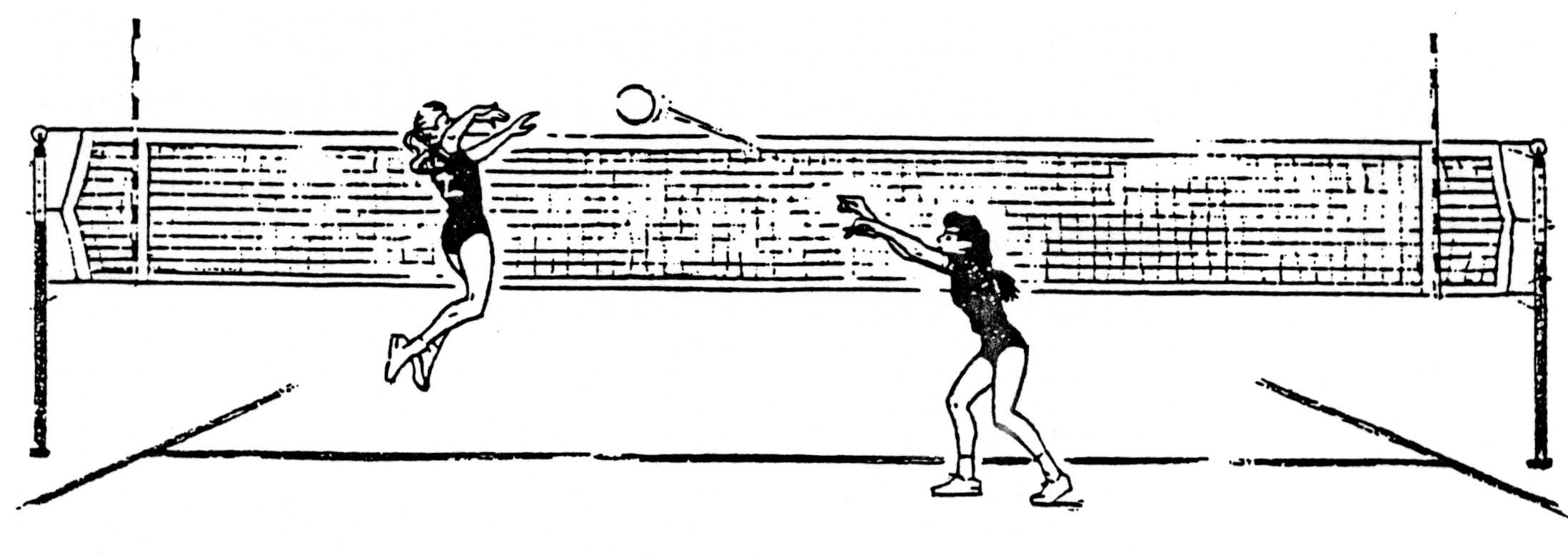
An advanced team will make use of five types of set. Besides the high and outside regular set to the left-front or right-front attacker called a "FIVE", good teams make use of a low quick set near the center of the net to its middle attacker. This type of set is labeled a "ONE." A low, quick set halfway between the left sideline and the setter is called a "THREE." This set is also directed to the middle attacker. A low-to-medium height set to the left-front attacker is called a "FOUR." A "TWO" ball is used by teams with above average skills and is delivered to the middle attacker. On advanced teams, the "TWO" set is used for combinations of hitters.
The ONE BALL
The one provides the key to the quick attack. It forces the middle-blocker to wait and, perhaps, jump before moving to block near the sideline.

The middle blocker has a problem with teams that run a successful middle attack. The attacker opposite her is jumping to spike. If she does not wait and at least raise her hands, the attacker hits an unobstructed one.
If the middle blocker waits too long and the set goes elsewhere, she may be too late to help her teammate block. The attacker has the one-on-one matchup she ought to win.
This type of strategy occurs often in advanced volleyball. All combinations begin with the quick set called a "one."
The TWO BALL

The two is a medium-height set that can be directed to any player on the court, including those in the back row. Above average teams will use the two ball to quicken its middle attack. Advanced teams quicken its right-side attack with a long, back two.
The two, often called the "play set" or "combination set," is the workhorse of the middle attack. When a blocker jumps with a quick attacker, the second attacker hits a two. The setter uses the two as an alternative to a quick set when she has to come off the net to get to a short pass or the hitter is late.
The height of a two ball can be 2-4 feet above net. The setter determines the height based on her attackers' tendencies, the play, and available hitters.
The THREE BALL

The three, or inside shoot, is a quick set, usually directed to the middle-front attacker. Like the one, it functions both to score points and to draw blockers from other attackers.
At its high point, the three ball reaches less than 3-feet above the net. It moves fast, meeting the hitter about halfway between the setter and the left sideline. The spiker attempts to jump and contact the ball before the middle and outside blocker converge to block her.
To time the fastest three, the spiker jumps as the ball leaves the setters hands. To run a slower three ball, the hitter must be preparing to jump as the ball touches the setter's hands.
The FOUR BALL

The four, or outside shoot, is a low fast set that is directed to the left-front attacker. At its high point, the four is 3-5 feet above the net. The greater distance between the setter and the spiker makes the difference. The outside shoot moves faster, and is more difficult to time, than any other set. The left-front attacker meets the ball on the left sideline. The left-front attacker wants to jump and contact the ball before the middle-blocker moves and joins her left-blocker teammate.
The FIVE BALL
The five, or high set, is the most common type of set for beginning teams. This set can be delivered to any hitter any where on the court. Above average teams will combine the high outside set to either of its outside hitters with the quick middle attack. Advanced teams use the five ball as a safety set when the setter receives a poor pass and can not run the designed play.
The high point of the five ball is 5-8 feet above the net and sometimes can be much higher depending upon the skill of the setter and other players. All hitters will wait until the ball has reached its high point before beginning their approach.
